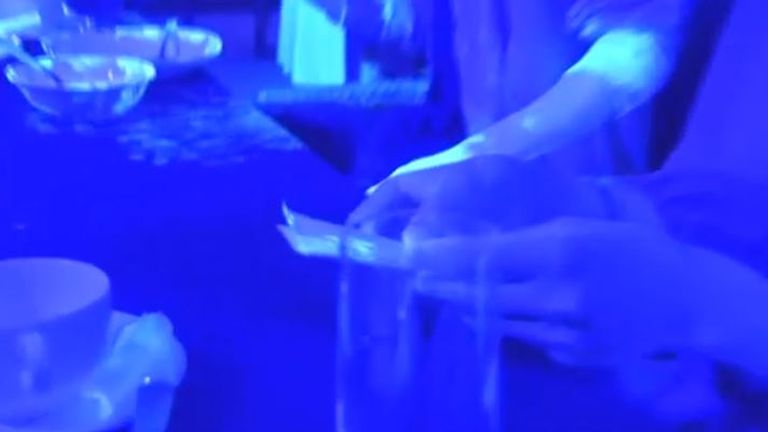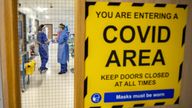Coronavirus: Restaurant experiment shows how quickly COVID-19 spreads
Further research finds speaking loudly spreads more of the disease which remains in the air for more than eight minutes.
Thursday 14 May 2020 15:50, UK
An experiment using a black light has shown how quickly germs and viruses can be spread in restaurants when just one person is infected.
Hundreds of tourists were infected with COVID-19 on a cruise ship in Japan, with a buffet on the ship believed to be where most people got it.
The new experiment simulates how far a virus can spread at a buffet venue by using a paint invisible to the naked eye to represent the virus.
Conducted by Japanese state broadcaster NHK in liaison with infection experts, the video shows 10 people coming into the restaurant, with one of them "infected" with the paint.
The group sits down at a table before going to the buffet table to dish out food onto their plates before sitting back down to eat.
Black lights are then turned on, illuminating where the "virus" has spread from the one person.
The paint, which shines white under the light, can be seen on the hands of all the participants and on the faces of most of them, especially around their mouths.
It is also on the food, tongs, the lid of the food containers, the handle of a drink jug, all the crockery, the table cloth and the bill.
John Nichols, professor in pathology at Hong Kong University, told CNN the video "really highlights the need of what people have been saying about hand hygiene to stop the spread of disease".
:: Listen to the Daily podcast on Apple Podcasts, Google Podcasts, Spotify, Spreaker
The video was released as research by Stanford University found speaking transmits the virus.
The louder people speak, the more droplets are dispersed, the study found.
Researchers said with just one minute of loud speaking, at least 1,000 infected droplets remain in the air for more than eight minutes.
These can then be inhaled by other people, triggering a new COVID-19 infection.







